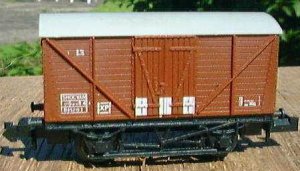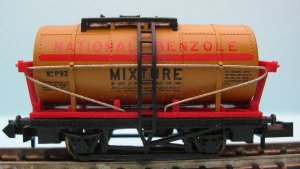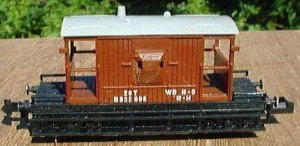Minitrix
(formerly Hornby Minitrix - Now discontinued)
At the higher priced end of the RTR market these are well made wagons. Production moved to Germany in the early 1990's which resulted in much higher prices and for a while several models were not available. This appears to have been resolved now however and the current distributor advises that the goods stock should soon be available again. The liveries supplied, other than PO and the HAA hopper, are all early BR. In spite of their stated policy of catering to the early BR period the National Benzole tank is in the 1909 to 1939 livery for Class A flammable liquids.
The standard wagon underframe has LNER type axle boxes and a tiebar and represents a `fitted' design, but only has 4 brake blocks instead of 8. Note these now seem to be being produced with blackened wheels for the new importers, a welcome development. The bodies of the 10' wheel base stock are a shade large for transferring to Peco chassis kits but a Peco or Graham Farish body mounted on a Minitrix chassis is a good starting point for 'shock-absorbing' stock and the Minitrix body can be fettled onto a Graham Farish chassis.
Chassis details
10 foot wheelbase : An RCH standard type, it represents a vacuum fitted design with a tiebar between the axles. It is 38.5 mm OH, 21.5 mm wb and 50 mm OA.
HAA Hopper: (Not seen)
`AB' Vent Van: A steel underframe, with built in central step for the doors. It is 51 mm OH 28,5 mm wb and 63 mm OA.
8 PLANK OPEN- A useful 8 plank end-door mineral wagon, it is highly unlikely these would have used a vacuum fitted underframe. These wagons are suitable for the private owner fleets, the railway companies operated few eight plank wagons although the LNER had some. Should you encounter any of the old Woodhead Models complete wagon side transfers they were intended for this wagon.
Minitrix 8 plank repainted as an LNER wagon

STEEL OPEN- Available in grey or bauxite livery this is a reasonable representation of a BR 16 ton mineral wagon which was introduced under the 1955 Modernisation Plan. Grey was used for `unfitted' stock (i.e. with only a hand brake) and bauxite for the `fitted' stock (i.e. that fitted with a vacuum brake). The braked type were not a success in use and BR reverted to unfitted types for the final batches. The last 16 tonner was produced in November 1959 and I believe the last were withdrawn from revenue earning service in about 1988.
HAA HOPPER - A useful model of an early Merry-Go-Round 32.5 ton hopper. These were originally coded HOP 32 AB, and introduced in 1964, over 10,000 being produced. Again well detailed and at the higher end of the price range. The livery as supplied is post 1974 TOPS, however the lettering is now sometimes white on a black background framed in white boxes. The HAA is used for supplying regular customers such as power stations and it is fitted with automatic discharge gear. Top speed loaded is 45 mph and empty 50 mph. These wagons are being revamped with improved suspension and air brakes to enable speeds of up to 60 mph and re-classified as HFA. Some routes have sufficient clearance to allow side and ends extensions to be fitted to the hopper to increase their capacity and there was a kit available to suit the Minitrix wagon but at the time of writing I am unable to find any advertisements for this. In the early years a number of these wagons were built as covered hoppers with a solid roof with roof top hatches fitted and these remained in use into the late 1990s carrying limestone. Some of the open wagons were also converted to carry china clay, re-coded CDA they entered service in January 1988. The CDA has a motorised canvass cover or 'hood' and a conversion kit to suit the Minitrix wagon is available from Kingdom Kits (available via N Gauge Enterprises in Huntingdon).
SHOCK VAN - The shock-fitted version of a BR standard van. (also available from Lima, which see for further information). The shock absorbing gear is not shown under the doors on the model however this can be easily added using plastic rod or even a length of match stick about 12 mm long. The short white vertical stripe `shock van' markings replaced the original taller, thinner stripes. The earlier type markings were also added to the ends of the vehicle and both forms of marking were seen into the 1970's.

TANK WAGON - An RCH standard tank wagon to a design introduced in the 1890's and still in service up into the 1970's. Suitable for Big Four and BR steam/diesel era, the National Benzole livery is actually for the pre war period, and very handy too. A well detailed model, one small point worth noting is the vertical end supports on the frame should be painted black, the red was only painted on the horizontal section across the end of the tank on Class A tanks.

BOGIE BALLAST- This is not a BR design, it appears to be a continental type.
LONG OPEN WAGON - A continental design for which I have not found any very similar British design.
BOGIE VAN - A continental type, possibly seen in UK on ferry trains from Europe. This sort of wagon is being produced in the UK these days, but I have not found any examples of this particular design in the limited amount of modern image reference material at my disposal.
CAR WAGON - A continental (German) design, actually this is a standard steel open wagon with the doors and ends removed and a second floor fitted, a common sight in long rakes in Germany (in the late 70s and early 80s at least) but not seen in Britain.
`AB' VENT VAN - A continental (I believe German) design, it has a fourteen foot wheelbase and a body twenty five foot long. It can be useful as the basis for various pre-grouping and Big-Four era CCT vans and also for GWR/LNER and BR wooden bodied grain/cement hopper vans but this probably requires more work than using Peco parts.
BR BRAKE VAN- BR standard design, based on the LNER type (See under Peco for further information on this). A nice model.

^
Go to top of page



